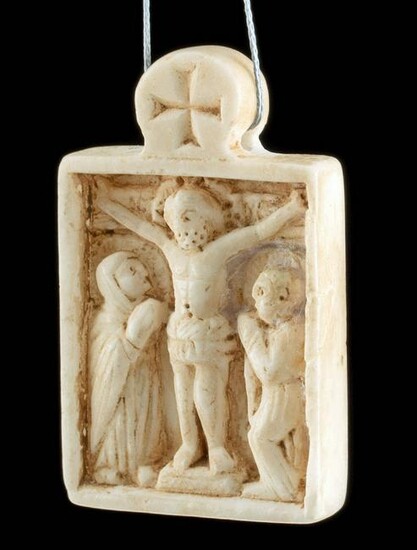10th C. Byzantine Marble Pendant Christ on Cross
Ancient Near East, Byzantium, ca. 10th century CE. A miniature marble carving depicting Christ on the Cross flanked by Mary and St. John the Evangelist who press their hands together in prayer and look up at Jesus. This scene is depicted in relief within a rectangular panel above which rises an integral orb-shaped finial that is carved with a Byzantine Cross and laterally perforated at its base for suspension. The details are remarkable for a carving of this size. Notice the sculptor's attention to Mary's and John's facial features, halos, and hands as well as the drapery folds of their clothing. When looking at the Christ figure, his finely modeled beard, Crown of Thorns, and taut chest are impressive as is the delineation of the Cross behind. Size: 1.375" W x 2.25" H (3.5 cm x 5.7 cm)
Nevertheless, it is clear that the Byzantine artist was not as concerned about naturalism as the classical artists who preceded him. Christ's arms are almost as long as his legs - perhaps to emphasize the drama of the Crucifixion, and the hands of Mary and John are quite large, perhaps to emphasize their prayerful gestures. However, these ambiguities do not detract from the beauty of the piece. They simply signify a new artistic direction of the Byzantine era - emphasizing the spiritual as opposed to the natural.
The death of Christ is an important image in the history of art. The first image of the Crucifixion that we know of arose during the 6th century; however, the theme was not very common until the Carolingian period when it was depicted on ivories, metalwork, and illuminated manuscripts. The Crucifixion would then become a focus of religious artists in the later Medieval, Renaissance, and Baroque periods.
Provenance: ex Estate of Eldert Bontekoe, Pegasi Numismatics, Ann Arbor, Michigan USA acquired before 2000
All items legal to buy/sell under U.S. Statute covering cultural patrimony Code 2600, CHAPTER 14, and are guaranteed to be as described or your money back.
A Certificate of Authenticity will accompany all winning bids.
We ship worldwide to most countries and handle all shipping in-house for your convenience.
#157946
Condition Report: Small repair to upper end of left proper integral frame (2 pieces that together measure .75" long). Minute surface divot to top of orb finial with dark deposits. Carved imagery is strong. Scattered deposits in recessed areas as shown. Collection labels on verso. Laterally perforated at base of the integral orb-shaped finial atop the plaque that will serve for suspension if so desired.
View it on
Estimate
Time, Location
Auction House
Ancient Near East, Byzantium, ca. 10th century CE. A miniature marble carving depicting Christ on the Cross flanked by Mary and St. John the Evangelist who press their hands together in prayer and look up at Jesus. This scene is depicted in relief within a rectangular panel above which rises an integral orb-shaped finial that is carved with a Byzantine Cross and laterally perforated at its base for suspension. The details are remarkable for a carving of this size. Notice the sculptor's attention to Mary's and John's facial features, halos, and hands as well as the drapery folds of their clothing. When looking at the Christ figure, his finely modeled beard, Crown of Thorns, and taut chest are impressive as is the delineation of the Cross behind. Size: 1.375" W x 2.25" H (3.5 cm x 5.7 cm)
Nevertheless, it is clear that the Byzantine artist was not as concerned about naturalism as the classical artists who preceded him. Christ's arms are almost as long as his legs - perhaps to emphasize the drama of the Crucifixion, and the hands of Mary and John are quite large, perhaps to emphasize their prayerful gestures. However, these ambiguities do not detract from the beauty of the piece. They simply signify a new artistic direction of the Byzantine era - emphasizing the spiritual as opposed to the natural.
The death of Christ is an important image in the history of art. The first image of the Crucifixion that we know of arose during the 6th century; however, the theme was not very common until the Carolingian period when it was depicted on ivories, metalwork, and illuminated manuscripts. The Crucifixion would then become a focus of religious artists in the later Medieval, Renaissance, and Baroque periods.
Provenance: ex Estate of Eldert Bontekoe, Pegasi Numismatics, Ann Arbor, Michigan USA acquired before 2000
All items legal to buy/sell under U.S. Statute covering cultural patrimony Code 2600, CHAPTER 14, and are guaranteed to be as described or your money back.
A Certificate of Authenticity will accompany all winning bids.
We ship worldwide to most countries and handle all shipping in-house for your convenience.
#157946
Condition Report: Small repair to upper end of left proper integral frame (2 pieces that together measure .75" long). Minute surface divot to top of orb finial with dark deposits. Carved imagery is strong. Scattered deposits in recessed areas as shown. Collection labels on verso. Laterally perforated at base of the integral orb-shaped finial atop the plaque that will serve for suspension if so desired.



